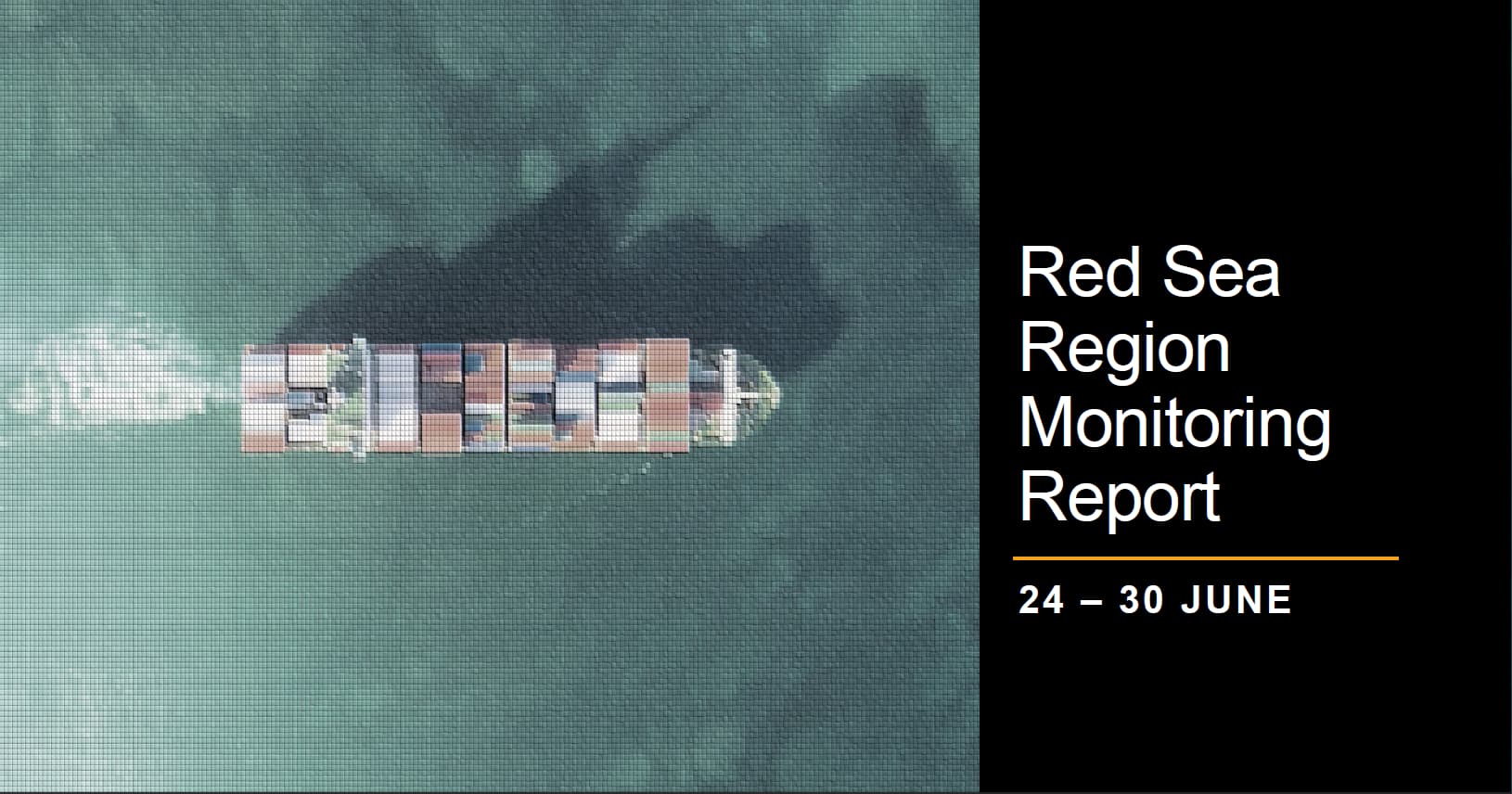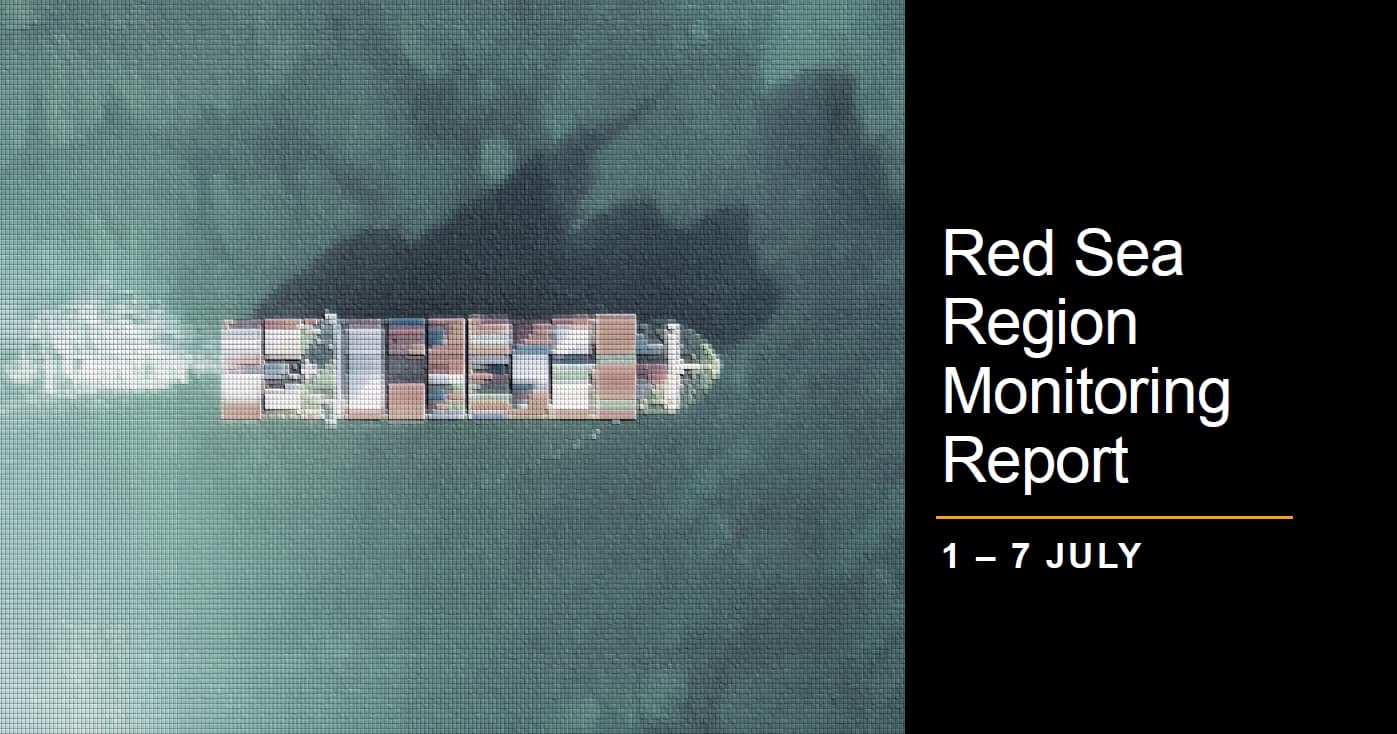KEY DEVELOPMENTS – COMMERCIAL INCIDENTS
During the monitoring period 18-24 March Regal Maritime Solutions (RMS) identified the following incidents in the Red Sea and Gulf of Aden region:
SUSPICIOUS ACTIVITY: On 20 March, approximately 160NM southeast of Salalah, Oman a commercial vessel was approached by small craft carrying around seven crew and had a visible ladder aboard. The craft approached approximately 0.3NM from the vessel and continued to follow the vessel for around 20 minutes before the armed security team aboard fired a warning shot, resulting in the small craft to depart the area.
SUSPICIOUS ACTIVITY: On 21 March approximately 102NM southeast of Nishtun, Yemen, a small craft approached within approximately 200 meters of a commercial vessel. The onboard armed security team responded resulting in small arms fire exchange between the security team and the occupants of the craft. The action resulted in the craft departing the area. All crew aboard were reported safe and the vessel proceeded to its next port of call.
MISSILE STRIKE: On 23 March the Chinese owned merchant vessel, Huang Pu was hit by a missile strike in the vicinity of 13 ° 20’ 00” N / 042 ° 50’ 00” E , resulting in minor damage and a fire onboard which was promptly extinguished. Whilst a distress call was issued, there was no request for assistance. No casualties were reported and the vessel resumed its course.

KEY DEVELOPMENTS – MILITARY ACTIVITY
During the monitoring period 18-24 March RMS identified the following incidents involving US coalition forces in the Red Sea and Gulf of Aden region, obtained from military and open sources:
MISSILE/UAV INTERCEPT: On 18 March, between 1300 and 1940 local time US military forces conducted pre-emptive strikes destroying seven anti-ship missiles, three unmanned aerial vehicles (UAV), and three weapons storage containers in Houthi-controlled areas of Yemen, considered as presenting an imminent threat to commercial and coalition warships in the region.
UAV/USV INTERCEPT: On 20 March between 1000 and 1940 local time, coalition aircraft intercepted and destroyed one UAV, whilst US forces destroyed one unmanned surface vessel (USV). Both weapon systems were launched from Houthi-controlled areas of Yemen. There were no reported injuries or damage reported either US or coalition warships.
USV INTERCEPT: On 21 March, between 0850 and 1140 local time, coalition aircraft successfully engaged and destroyed one USV launched from a Houthi-controlled area of Yemen.
MISSILE INTERCEPT: On 21 March coalition forces engaged and destroyed two anti-ship ballistic missiles (ASBMs) launched from Houthi-controlled areas of Yemen toward the Red Sea. There were no reported injuries or damage reported to U.S. or coalition warships in the region.
UAV INTERCEPT: On 22 March, between 0420 and 2310 local time US forces launched pre- emptive strikes targeting four unmanned aerial vehicles (UAV) in Houthi-controlled areas of Yemen considered as present an imminent threat to vessels in the region.
MISISLE ATTACK: On 22 March Houthi militants launched four anti-ship ballistic missiles (ASBM) from Houthi-controlled areas of Yemen toward the Red Sea but did not strike any targets. There were no reported injuries or damage amongst commercial and military vessels in the region as a consequence of the missile launches.
COORDIANTED MILITARY ACTION: On 22 March US forces conducted pre-emptive strikes against three Houthi underground storage facilities in Houthi-controlled territory of Yemen. The strikes targeted capabilities used by Houthi militants to threaten and attack commercial and coalition naval vessels in the region.
MISSILE STRIKE: On 23 March between 0250 and 0430 local time Houthis militants launched four anti-ship ballistic missiles (ASBM) into the Red Sea in the vicinity of M/V Huang Pu, a Panamanian- flagged, Chinese-owned, Chinese-operated oil tanker. At approximately 1625 local time, a fifth ballistic missile was detected as having been launched, striking the MV Huang Pu resulting in minimal damage and a fire onboard which was extinguished within 30 minutes. A distress call was issued but did not request assistance. No casualties were reported, and the vessel resumed its course. The Houthis attacked the M/V Huang despite previously stating they would not attack Chinese vessels.
UAV INTERCEPT: On 23 March between 0650 and 0950 local time US forces engaged six Houthi unmanned aerial vehicles (UAV) over the southern Red Sea, resulting in five crashing into the Red Sea and one returning to Houthi-controlled areas of Yemen.
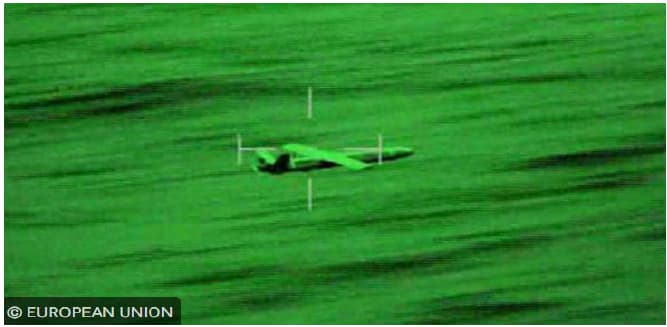
KEY DEVELOPMENTS – HOUTHI MISSILE STATISTICS
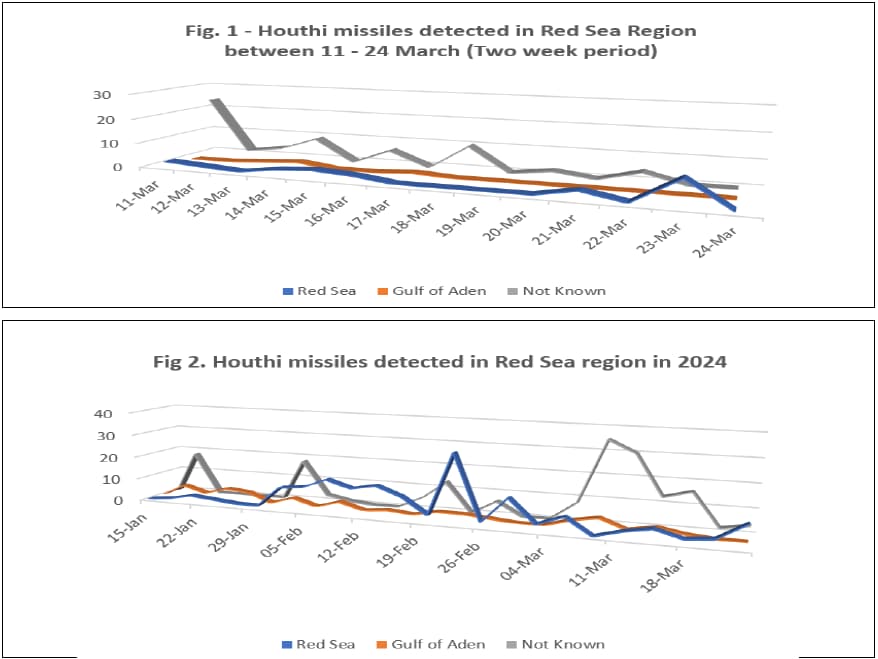
Figures 1 and 2 identifies the number of missiles, UAV, USVs and UUVs launched, or prepared to be imminently launched, by Houthi militants from Yemen targeting both commercial and naval vessels in the Red Sea and Gulf of Aden regions from data available from UKMTO, the US military and OSINT sources. Both figures have incorporated statistics from vessels hit, near misses and pre-emptive strikes on-land in Yemen by US- led Coalition forces but not those resulting from large scale coordinated military action. In some cases the destined target of Houthi weapons destroyed on-land in Yemen cannot not be verified and has therefore been categorised as ‘Not Known’ (NK). Where no dates are provided there were no reported incidents or data available for that period.
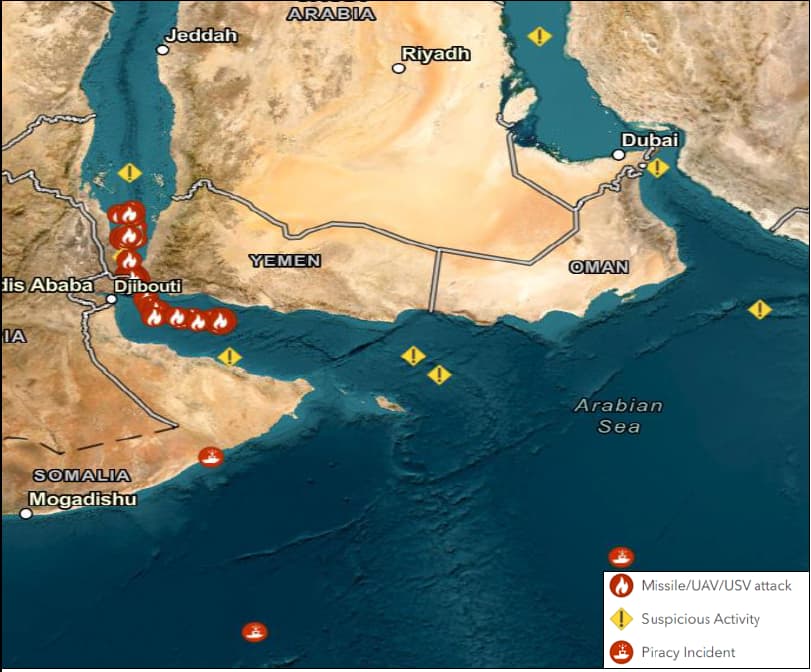
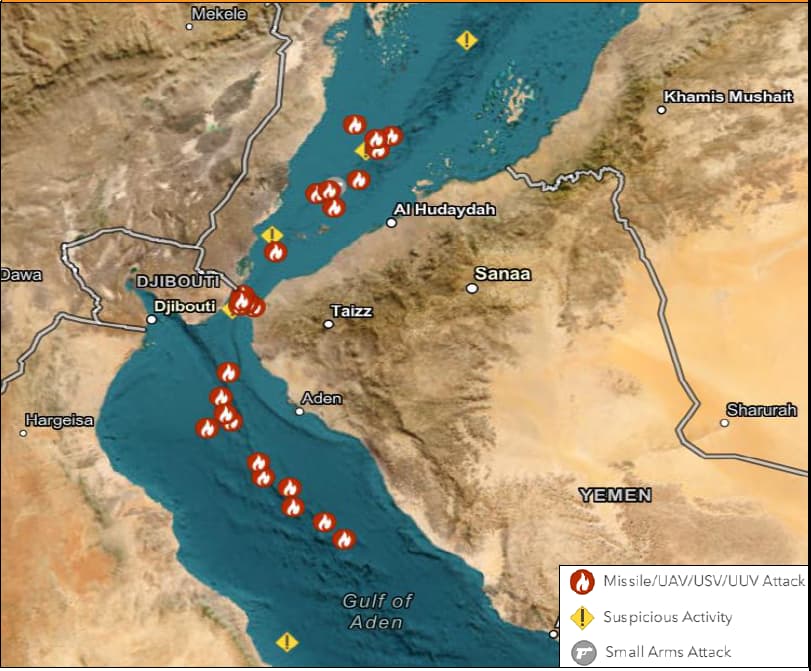
REGIONAL DEVELOPMENTS
During the monitoring period 18-24 March RMS identified the following key regional developments:
Russian and Chinese government officials came to an agreement with the Houthi group in Yemen to ensure the safe passage of Russian and Chinese linked vessels through the Red Sea trade route. Officials from both countries met with Houthi representatives in Oman last week demonstrating growing concern amongst key international powers of the Houthis current attacks in the Red Sea region. Whist the terms of agreement remain undisclosed, it is believed that Russia and China may lend political support to the Houthis on the international stage in exchange for their guarantee, aligning with the groups growing political and international ambitions.
On 23 March Houthi militants launched five anti-ship ballistic missiles targeting the Panamanian- flagged, Chinese-owned, and Chinese-operated oil tanker Huang Pu in the Red Sea resulting in minor damage to the vessel. This is despite earlier Houthi claims that the group would provide safe passage to Chinese and Russian ships transiting the region.
The head of the Houthi supreme revolutionary committee, Muhammad Ali Al-Houthi, criticised US and UK military strikes that occurred on 22 March targeting Houthi weapon storage facilities the vicinity of in Yemen’s main port city of Al-Hudaydah, claiming the attacks as “reckless“.
On 24 March, Muhammed Ali Al-Houthi warned any country that would act against Yemen or its interests would be considered a legitimate target for the Houthi group. Al-Houthi specifically warned Saudi Arabia of retaliation should they support US or UK military action against the group, increasing further pressure in the April 2022 truce between both countries following years of conflict.
The Iranian Behshad intelligence vessel is located in the vicinity of coordinates 11° 15′ 43.7″ N, 044° 28′ 01.8″ E approxiamltey 47NM north east of Lughaya, Somalia at the time of this report.
Over the reporting period a number of Houthi weapon intercepts by EUNAVFOR ASPIDES warships in the Red Sea region took place. On 20 March a French military helicopter intercepted and destroyed a UAV, followed by a further incident on 21 March in which a French destroyer intercepted and destroyed three ballistic missiles launched from Houthi territory. Meanwhile, the German warship FGS HESSEN destroyed a USV whilst conducting close protection duties to a commercial vessel in the Red Sea. So far, Mission ASPIDES has shot down eight UAVs and repelled three other UAV attacks since deploying to the region.
Negotiations between Israel and Hamas continue to edge closer to an agreement after Israel indicated it may be willing to double the number of Palestinian prisoners held in Israeli prisons in exchange for 40 hostages being held by the group in Gaza. However a key area of contention is Hamas’ request that 30 high-value Palestinian prisoners be released for each female IDF hostage held.
Hezbollah launched approximately 50 rockets into northern Israel in one if its heaviest barrages since hostilities began in October 2023. The attack comes as the Israeli military have increasingly launched airstrikes deeper into Lebanese territory over recent weeks pushing the limits of expanding the conflict further in the region.
The Islamic Resistance in Iraq have promised to escalate attacks on Israel during the month of Ramadan which is due to end on 9 April. The remarks by the group comers after it claimed to have launched a UAV attack targeting the Israeli Defense Ministry in Tel Aviv on 23 March. This follows other recent operations claimed by the group in Israel, including assaults on Ben Gurion Airport, a power plant in Tel Aviv, and key Israeli ports.
The US has imposed sanctions on the shipping company, Vishnu Inc, which it accused of facilitating the transfer of Iranian commodities, linked to a Houthi official, to China. It’s claimed that a vessel belonging to the company, registered in the Marshall Islands, participated in ‘illicit shipments’ in support of Iran’s Islamic Revolutionary Guard Corps – and Houthi Financier Sa’id al- Jamal, who is sanctioned under US counterterrorism legislation. The Vishnu Inc vessel reportedly received the cargo from a vessel known as Mehle, which is associated to a company linked to al- Jamal.
The Houthi’s one way attack UAVs, the Sammad and Waid-2, with a range of approximately 1800km and 2500km respectively, are known to be able to reach distances into the Indian Ocean. The weapon systems are consistent with the Iranian Sayed and Shahed-136 UAVs. The Waid-2 has been identified as being used by Russian forces in Ukraine, named Geran-2. This capability combined with recent Houthi intent to target vessels in the Indian Ocean region mentioned on 14 March may indicate efforts by the group to acquire the relevant parts for the desired weapon systems.
SAMMAD Unmanned Aerial Vehicle – Range 1800km
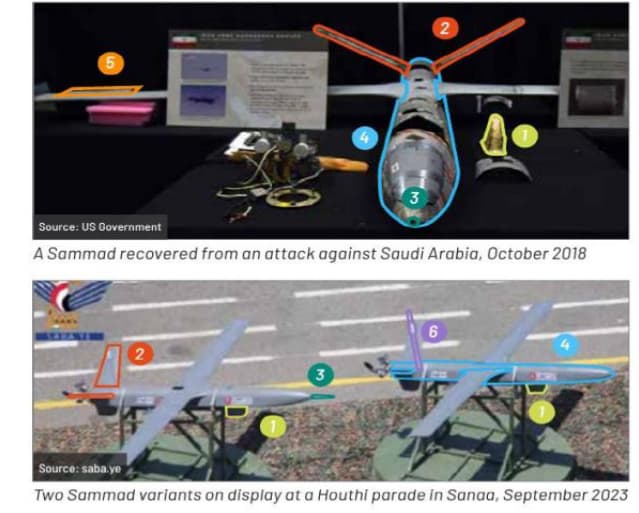
WAID-2 Unmanned Aerial Vehicle – Range 2500km
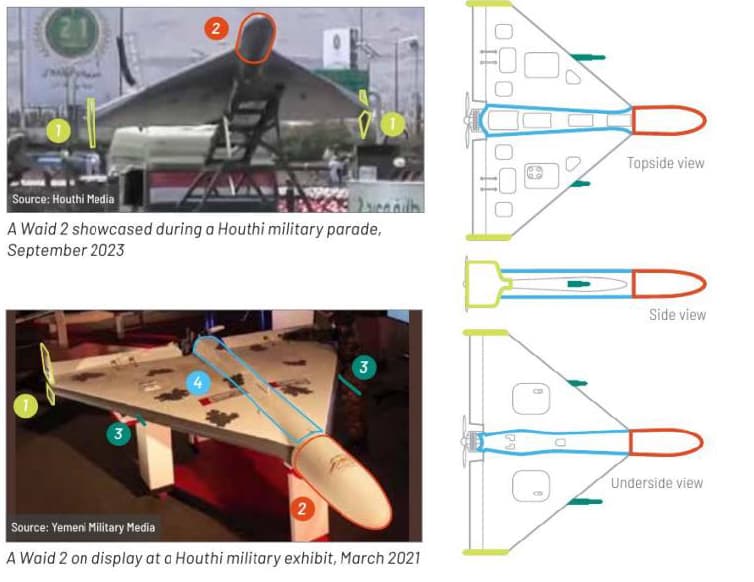
ASSESSMENT
- Houthi attacks will continue to target commercial and military vessels in the Red Sea and Gulf of Aden, in particular those with links, and/or tenuous links to Israel, the US and the UK.
- Any ceasefire between Israel and Hamas, would likely see a pause in attacks by Houthis on commercial shipping.
- The Houthis will likely be intending to acquire necessary weapon components for the assembly of Sammad and Waid-2 weapon systems as to follow through their threat to target vessels further afield in the Indian Ocean.
- Reports of the Houthi’s hypersonic missile test remains uncorroborated. Nonetheless their ambition to possess and manufacture such a weapon would pose a major challenge to commercial vessels and military warships in the region which would test coalition air defence systems.
- Iran will continue to smuggle weapon components to Houthi militants via Al-Hudaydah port, shipping vessels and through arms smuggling networks within the territory controlled by Yemen’s internationally recognised government (IRG).
- The Houthis will try to make a concerted effort to avoid vessel misidentification of Russia and Chinese vessels passing through the Red Sea region following the MV Huang Pu missile strike, and following an agreement made between all parties earlier in the week to allow safe passage for Chinese and Russian vessels.
- Houthi use of outdated and inaccurate data pertaining to target identification will likely remain inaccurate in the short term increasing the risk to non Israeli, US or UK linked vessels. The recent incident involving the Chinese vessel, the MV Huang Pu will pressure them to review and improve their current assessment process.
- Iran will continue to monitor and restrain Houthi ambition where necessary, should it look to compromise Iran’s wider strategic objectives in the region, or provoke direct US or Israeli military action against its immediate interests.
- The US and its partners will continue to conduct pre-emptive strikes against Houthi targets on-land in an attempt to degrade Houthi military capability.
- The US will continue to intensify efforts to intercept vessels smuggling weapon components from Iran to the Houthis in Yemen and expand their intelligence collection capacity to enhance maritime interdiction operations, as well as coordinate military strikes against Houthi weapon sites, faciltiies and capabilities in Yemen.
- The US government will continue to push for a diplomatic solution for the Israel-Hamas conflict with regional partners due to the ongoing humanitarian crisis in Gaza and attempt to dissuade wider conflict from escalating in the region.
- Piracy incidents around the Horn of Africa is still expected to increase as a consequence of Somali fishing policy and opportunism by Somali based Piracy Action Groups (PAGs) seeking to take advantage of the security vacuum along the east Africa coastline as a consequence of Houthi attacks in the Red Sea region
RECOMMENDATIONS
- Avoid being in vicinity of Iranian Behshad vessel.
- Be aware of potential US, coalition or Israeli Navy activity nearby in north of Red Sea, Bab-al-Mandab strait and Gulf of Aden.
- Vessels operating in the Indian Ocean area are urged to heighten their vigilance due to increased likelihood of Pirate Activity Groups (PAGs) operating in the area.
- Report any Suspicious Sightings and be aware of the risk of Unmanned aerial Vehicle (UAV) / drone and Uncrewed Surface Vehicle (USV) attack.
- Consider utilising a digital monitoring system, which incorporates UAV/UUV drone monitoring to warn of potential attack and use of physical barriers, such as nets and underwater barriers, that can be deployed to prevent UUVs from approaching a ship. These barriers can entangle or obstruct the movement of a UUV.
- Ensure crew conduct drills and training exercises to respond to UUV threats so that they are well-prepared to take appropriate action in the event of an incident.
- Follow guidance on loitering munitions as per the OCIMF website: https://www.ocimf.org/publications/information-papers/loitering-munitions-%E2%80%93-the-threat-to-merchant-ships
- Implement and review BMP5 in particular section 2, which describes non-piracy threats and the Global Anti-Piracy Guide.
- Consider mentioning vessel location to Flag Authorities.
- Inform UKMTO/MSCHoA of vessel movements.
- Ensure radar is kept on.
- Communicate with local agents for any local information or intelligence.
- Keep VHF Ch16 on and pay attention to advisories. Ensure strict surveillance of communications and establish communication with all approaching vessels.
- Do not allow small boats to approach or dock. Consider utilizing an armed security team aboard.
- Ensure there is Hard Cover available if on deck and that it is accessible.
- Ensure a Secondary Muster Station is considered and identified to crew and not just the citadel.
- Maintain Bridge Watches. (Please be aware at night, small, slow vessels without a wake are difficult to detect on radar). Keep Traffic on Upper Deck to a minimum
- Ensure all fire-fighting equipment is checked and available for immediate use. Including the emergency fire pump and that relevant maintenance has been conducted.


